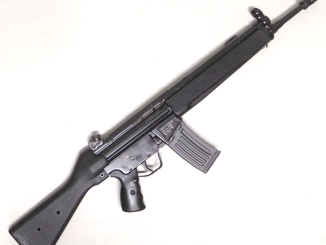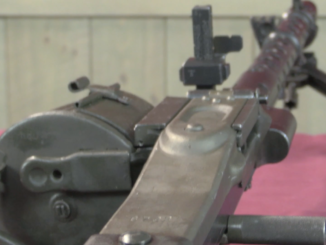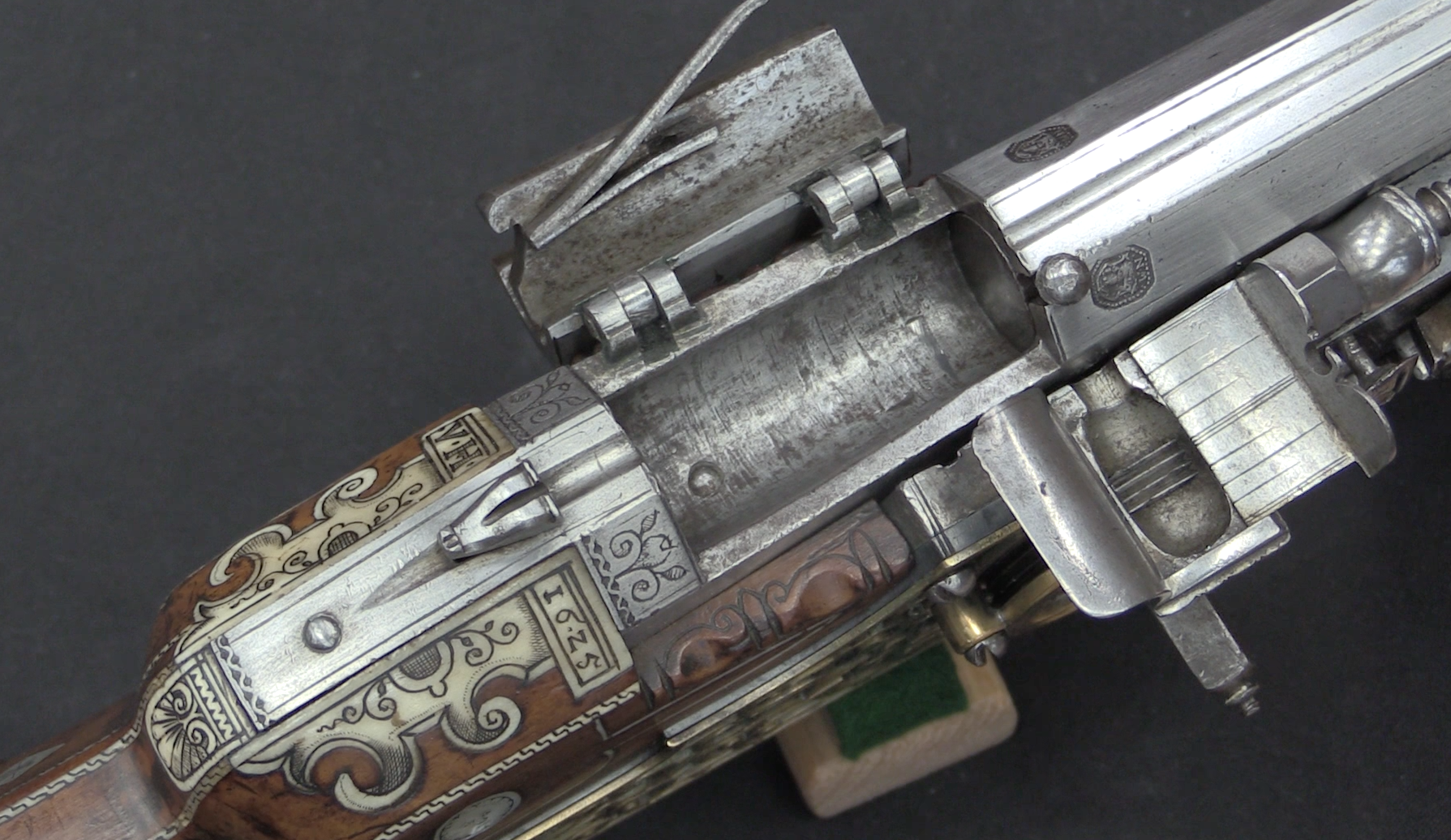Courtesy of Legacy Collectibles, we have a pair of Luftwaffe-issue Walther pistols to look at today, one PP and one PPK. The Luftwaffe bought more than 500,000 pistols during World War Two, including not only Walthers but also the Luger, P38, HSc, CZ38, Femaru 37, and FN 1922. Identifying Luftwaffe-issue Walthers is tricky, as they were not specifically marked – but we do know a few specific serial number batches.
As with other state and military organizations, Walthers made for the Luftwaffe were sold as special contracts, with unique serial numbering procedures. Specifically, Luftwaffe guns will have magazines serialized on their floor plates. The three specifically known groups are:
- From 1940, about 1800 guns chambered for 9x17mm, between 198,000P and 202,000P
- From 1941/2, about 12,000 PPs in .32 caliber between 216,000P and 229,000P
- From 1941/2, about 6,000 PPKs in .32 caliber between 297,000k and 304,000k
Other Luftwaffe guns exist, but their serial number blocks have not yet been identified.
Make sure to check out Legacy Collectibles’ YouTube channel! They have a bunch of videos on interesting firearms and firearms collecting.




In addition to their field divisions, Fallschirmjager (paratroopers) formations were also a branch of the Luftwaffe.
In addition to the trash in the Field Divisions, the FLAK (2, 3.7, 8.8, 10.5 and 12.8 cm guns) belonged to Goering. And yes, they used them all as anti tank guns in necessary. In Normandy, after Allied bombers had carpet bombed his front, Col Hans Von Luck rushed to the front to organize a defense against the coming attack. Finding a FLAK battery, he told its commander to engage the rapidly approaching British tanks to be informed that was not their job, they were supposed to shoot airplanes. An astounded Von Luck, thoroughly enraged, pulled out his P38 and informed this bureaucrat in uniform that he had a choice, he could “Either earn a Knight’s Cross or die where he stood”
(“After the war, Luck wrote that he was responsible for this barrage of anti-tank fire, saying that he used his sidearm to threaten a Luftwaffe officer into action, to fire upon the advancing tanks with 88 mm flak guns”)
Couple of points… The “trash” in those Luftwaffe Field Divisions was from exactly the same manpower base as the rest of the vaunted Heer and Waffen-SS formations. The difference was that they were trained by the Luftwaffe for ground operations, and kept under Luftwaffe command. This means they did not get the benefit of Heer training, or the weaponry. What the Germans did with that manpower was insane on the face of it, and the primary blame should go onto Goring, who didn’t want to see the size of his cherished toy diminished.
If anything, we ought to be grateful that the Luftwaffe manpower was never properly utilized. Denigrating them due to their poor performance, however, is a bit less than charitable–They were what they were due to the Nazi mentality, and Goring’s massively inflated ego. Frankly, from a purely military standpoint, you have to pity the poor bastards–They were never allowed to reach their full potential, thanks to the ego-driven nature of their utilization. Had the Heer had their way, the Luftwaffe ground troops would have been run through their replacement system, and sent out through their replacement system as fully trained and indoctrinated ground troops. As it was, most of the assets taken up from the Heer, like heavy weapons and so forth, were wasted when the inadequately trained and inexperienced-at-ground-warfare Luftwaffe troops were massacred. Their record on the Eastern front is mostly pitiable, outside of the Fallschirmjager elements.
The LW ground divisions were a typical example of inefficiences caused by the Nazi party fiefdom-like (mis)organization. Even the much vaunted Waffen SS would have been overall more efficient if fully incorporated in the Heer organization.
Col Hans Von Luck was great german patriot, who would to kill everyone for his country, values and Great Leader. Glory to him and his small pistol.
You have to wonder how many of these were brought home as war trophies and shot to pieces – perhaps with the wrong ammon – and/or sold cheap or simply lost. As well as how many are still in sock drawers.
Great. Found a typo after posting, and it wasn’t even flagged as misspelled. Is “ammon” (still not flagged) a recognised abbreviation for “ammonia” or something?
“(…)something?”
Ammon is name of Iron Age nation:
https://en.wikipedia.org/wiki/Ammon
Also an old-fashioned spelling of the Egyptian god Amon in some languages. Not sure if it was ever usee in English, though.
I have read that the Vis Radom P35 pistols were popular with Fallschirmjager.
Considering that paratroops tend to carry light anyway, I’m certain that the average German paratrooper would have appreciated the FB Vis over a Walther PP. Until the Battle of Crete was over, the Luftwaffe thought that it was a good idea to stuff everybody’s main weapons (not the side-arms, mind you) in a separate canister that itself was parachuted along with the guys going down. And as it turned out, at least half of the weapons canisters fell into Greek and British hands! Oh, did I mention that a British officer captured a code-book and then faked some radio transmissions to get the Germans to airdrop supply crates on British-held areas?
Finns thought differently. They give the best pistols what they had for the pilots. Lot of air force personnel carried a FN HP as their service pistol. Thinking was that the pilots needed to have the best weapon what they could get if they would need to fight back to the own lines if their bomber or a fighter was shot down. I suppose FN HP with shoulder stock was a good choice back then.
“(…)Thinking was that the pilots needed to have the best weapon what they could get if they would need to fight back to the own lines if their bomber(…)was shot down.(…)”
It should be noted that German M. G. 15. count be dismounted, equipped with bi-pod and used in lieu of infantry machine gun. Naturally that was possible only in case of (less or more controlled) landing rather than bail-out.
There’s certain amount of difference between the way various countries thought about what the pilots ought to be doing, once shot down. Some felt they should be passive, and await rescue by others, or go quietly into captivity should that not happen.
There were a couple, however, that felt that the pilots ought to continue to do as much damage as they could, once on the ground. From what I remember reading of the matter, that was pretty much the Finnish attitude. If I am not mistaken, there was a Finnish pilot who was shot down inside Soviet lines, who then proceeded to capture small arms and equipment from the Soviets sent to take him prisoner, using that gear to conduct a small-scale guerrilla campaign all the way back to Finnish lines. When the Soviets saw the back of him, they were grateful to watch him leave their territory.
I can’t remember where the hell I read about that guy, but I came across it when I was researching the Winter War and the Continuation War. He did a significant amount of damage on his way out of Soviet-held Karelia, blowing up a couple of ammo dumps and doing some other things. I wish I could remember more details on the guy, because it put that meth-crazed Finn’s exploits to shame. Whole thing was “Well, you assholes shot my plane down, now you’re going to pay…”.
I don´t know about that kind of event. Generally speaking, Finnish aircrew members were instructed to go back to their own lines after their plane was shot down. Maybe you read about Finnish recon forces which did a lots of damage behind the Soviet lines. They blow up the bridges, trains, ammo/fuel dumps etc. Usually they were flown behind the Soviet lines by seaplanes like Heinkel He 115.
Soviet held Karelia isn´t that faraway from Finland so aircrew members could simply walk back to own lines. It could take days, even weeks but it was possible to do.
Are the spare magazines also serialized? If so, is there anything to distinguish the two?
The main reason the Luftwaffe wanted Walther PPs and PPKs was for aircrews, and the primary consideration was weight. WW2 aircraft may look powerful to us today, but other than the American and British ones most were suffering from horsepower limitations, which meant that every ounce (or gram) of mass had to be carefully considered vs the mission objectives.
As such, the weight of six pistols for the crew of a Heinkel he 111 had to be factored in. Six Walther PPs weigh about half what six P.08s do.
The RAF had the same issue even with their powerful Merlin engines. That’s why they issued the Webley MK IV (commercial) 0.380in revolver to fighter pilots and bomber crews instead of the standard Enfield MK II* 0.380in; the Webley weighed four ounces less than the Enfield.
As to what they were actually for, the Luftwaffe was mainly interested in aircrew survival in remote areas, not offensive activity once on the ground. All bombers were equipped with two sets of clamp-on rifle butts and bipods for their MG15 flexible MGs;
https://cdn.shopify.com/s/files/1/1524/1342/products/on2811__12_1.jpg?v=1571454064
Thus when forced down in, say, North Africa, the aircrew had a more telling argument vs. the locals than just pistols.
They also issued the Sauer M30, a sporting-type rifle-shotgun combination called a “drilling” (due to having three barrels) specifically for survival hunting and foraging;
https://4.bp.blogspot.com/-GOnUcRMnqCc/VntTx2JnVYI/AAAAAAAAEYs/hle74E9Upjw/s1600/tumblr_mba64uCK321rcpl5zo1_1280.jpg
https://cdnb.artstation.com/p/assets/covers/images/008/200/957/large/chillydog-3d-23667716-175218096393389-8946225622674309120-n.jpg?1511144783
When Luftwaffe pilots and aircrews were shot down over England, they surrendered their weapons pretty much as soon as anybody found them. Partly due to not wanting to get into a gunfight with the Home Guard or whoever, but mostly because they knew that the worst thing that would happen to them was spending the rest of the war in a camp in Canada.
Among other things, this meant that there were probably a lot of German handguns in England that were not collected to be melted down or cut in two with a torch and then dumped in the North Sea in 1946. Which probably worries the British government (whoever it is) to this day.
cheers
eon
I agree on the point of weight savings for air crews, but then many officers commanding a desk in Marine and Heer also carried 7,65 Browning or 9 mm Kurz pistols. No different from their Luftwaffe colleagues. Also the pistols in the video look very well and have not seen much use which leads me to suspect they had been issued to desk pilots.
Eon:
I would be surprised if the Enfield and Webley revolvers differed by four ounces. My copy of “Small Arms of the World” by Hogg & Weeks has the Enfield at 780g and the Webley at 760g, the difference of 20g being less than an ounce. I would have expected that, as the revolvers are so very similar. The RAF may have issued Webleys as the Army was getting all the Enfields, which is a bit similar to the German situation between the Heer and Luftwaffe, ironically.
Even more ironically, after the war the Walther PP in 7.65mm became the standard RAF aircrew pistol, as the L47A1. It is only a few years back that they were replaced by something boring like a Glock 17. This being Britain, I can safely say that the Walthers will have been scrapped. Obviously British people cannot own them, and I am sure the British government would not do anything as stupid as earning a few dollars by selling them to collectors anywhere else in the world, such as the USA.
Aw, phooey! It appears the British government is terrified of the idea of selling surplus pocket pistols to collectors on the grounds that somehow the “collector” may turn out to be some sort of evil madman who will turn the Walther into some sort of SUPER-WEAPON and then go out and commit MASS MURDER with it. Just kidding!
Cherndog:
You have summed up the thinking of the British government very accurately.
LOOKING FOR A cz83 380 phone 818 266 3527
CAN YOU DATE MY WALTHER PP 395964 NDS
RON